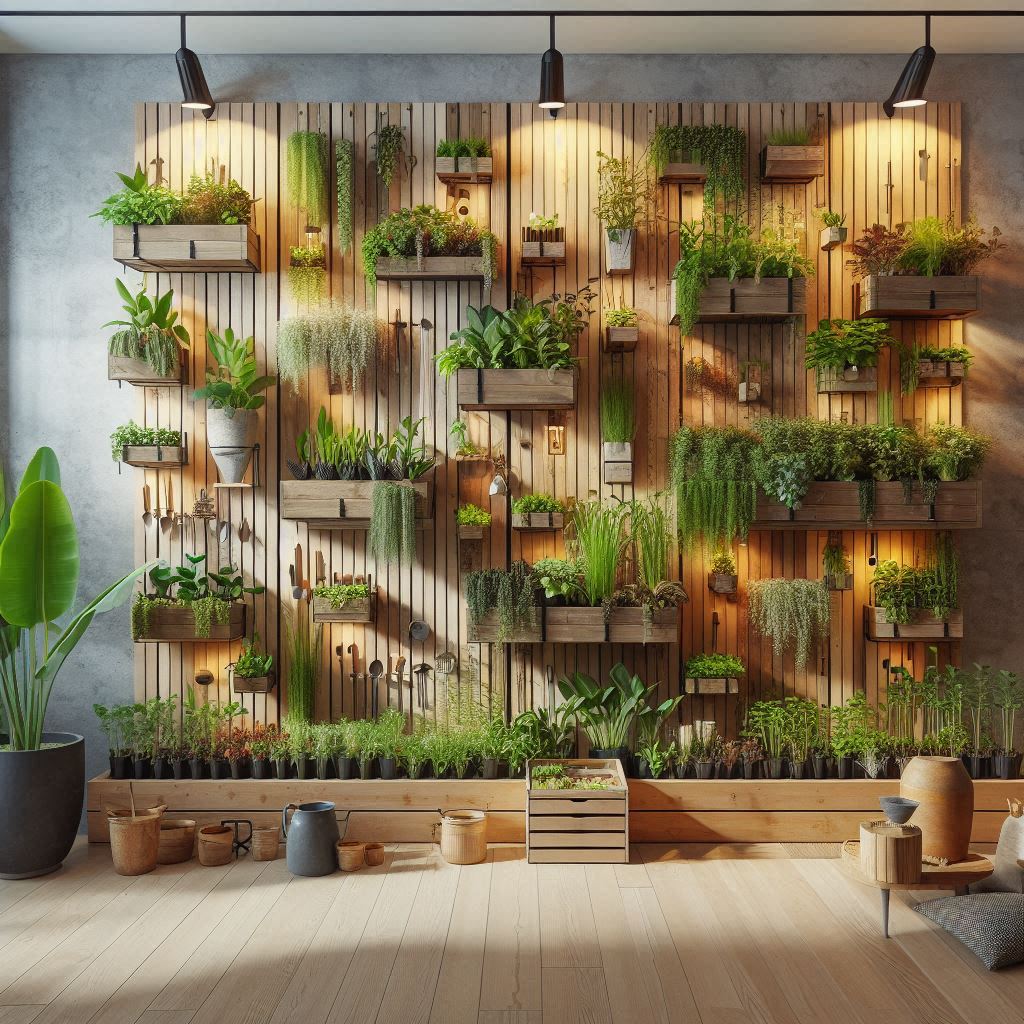For those of us with limited gardening space, or a yearning for a touch of green on a balcony or patio, vertical gardening offers a creative solution. By utilizing vertical space, you can maximize your harvest and cultivate a lush, living wall. Raised beds add another layer of functionality, improving drainage, soil quality, and accessibility.
This article explores 11 exciting DIY methods for vertical gardening in raised beds, allowing you to transform your space into a vibrant and productive oasis.
Unleash the Potential: Vertical Gardens in Raised Beds
Vertical gardening involves growing plants upwards on walls, fences, or freestanding structures. Combining this technique with raised beds creates a dynamic gardening system with a multitude of benefits:
- Increased Yield: By utilizing vertical space, you can significantly increase your planting capacity compared to traditional ground-level gardening.
- Space-Saving: Vertical gardens are perfect for small balconies, patios, or areas with limited ground space.
- Improved Accessibility: Raised beds make it easier to tend to your plants, especially for those with mobility limitations.
- Aesthetic Appeal: Vertical gardens add a beautiful and unique element to your space, creating a living wall that enhances your surroundings.
11 DIY Methods to Get You Growing Vertically:
Now, let’s explore the 11 creative methods to get you started:
(1) Tiered Planter Boxes:
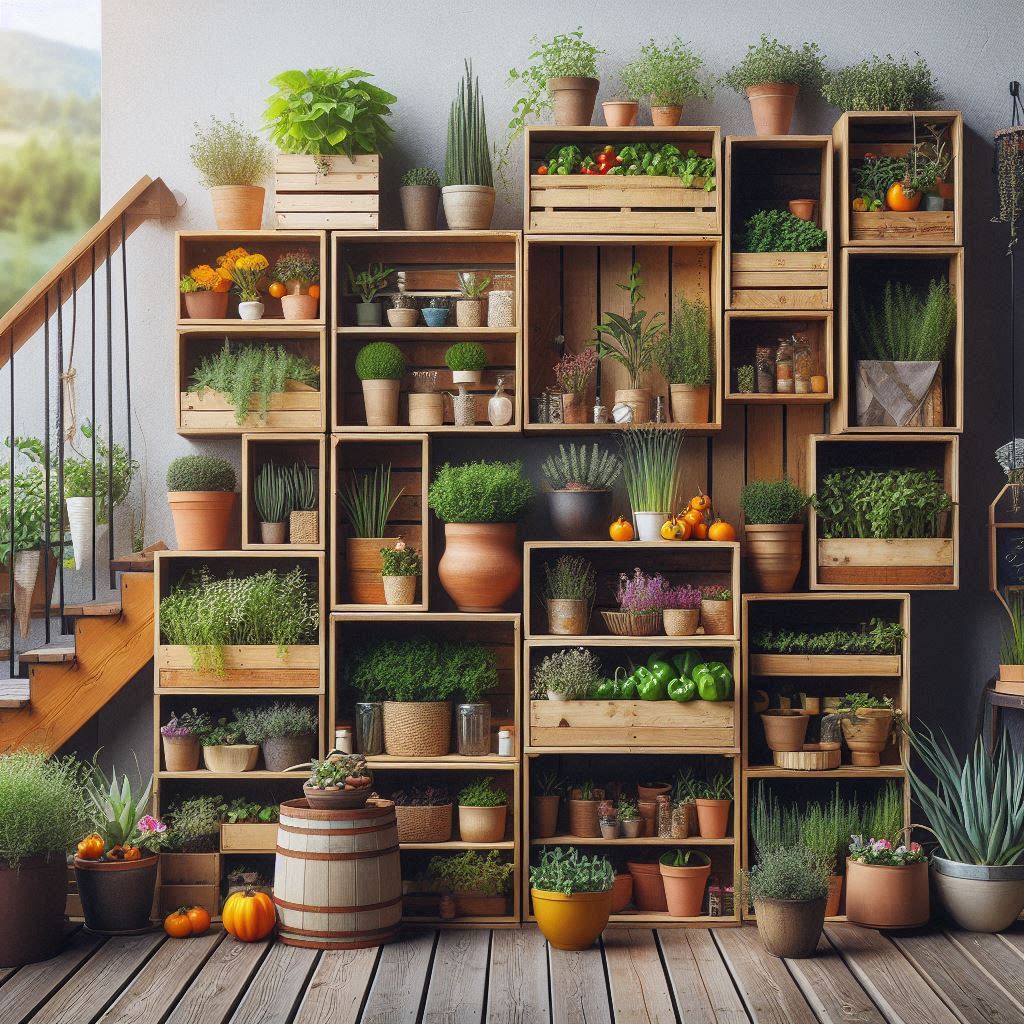
- Description: This classic method involves stacking multiple planter boxes on top of each other, creating a vertical tower for your plants.
- Materials List:
- Lumber (treated or cedar) for building the boxes (dimensions will vary depending on your desired size)
- Drill and screws
- Heavy-duty liner (optional, for improved moisture retention)
- Potting mix
- Pros & Cons: Easy to build, customizable size and design. May require more frequent watering due to increased surface area exposed to sun and wind.
- Building/Assembly Instructions:
- Cut lumber to desired lengths for the sides and bottom of each planter box.
- Assemble the boxes using screws and drill holes for drainage at the bottom.
- Line the boxes with heavy-duty liner (optional) and fill with potting mix.
- Stack the boxes securely on top of each other, starting with the largest at the bottom.
- Plant Recommendations: Herbs, lettuce, strawberries, and other shallow-rooted plants thrive in tiered planters.
(2) Vertical Fabric Pockets:
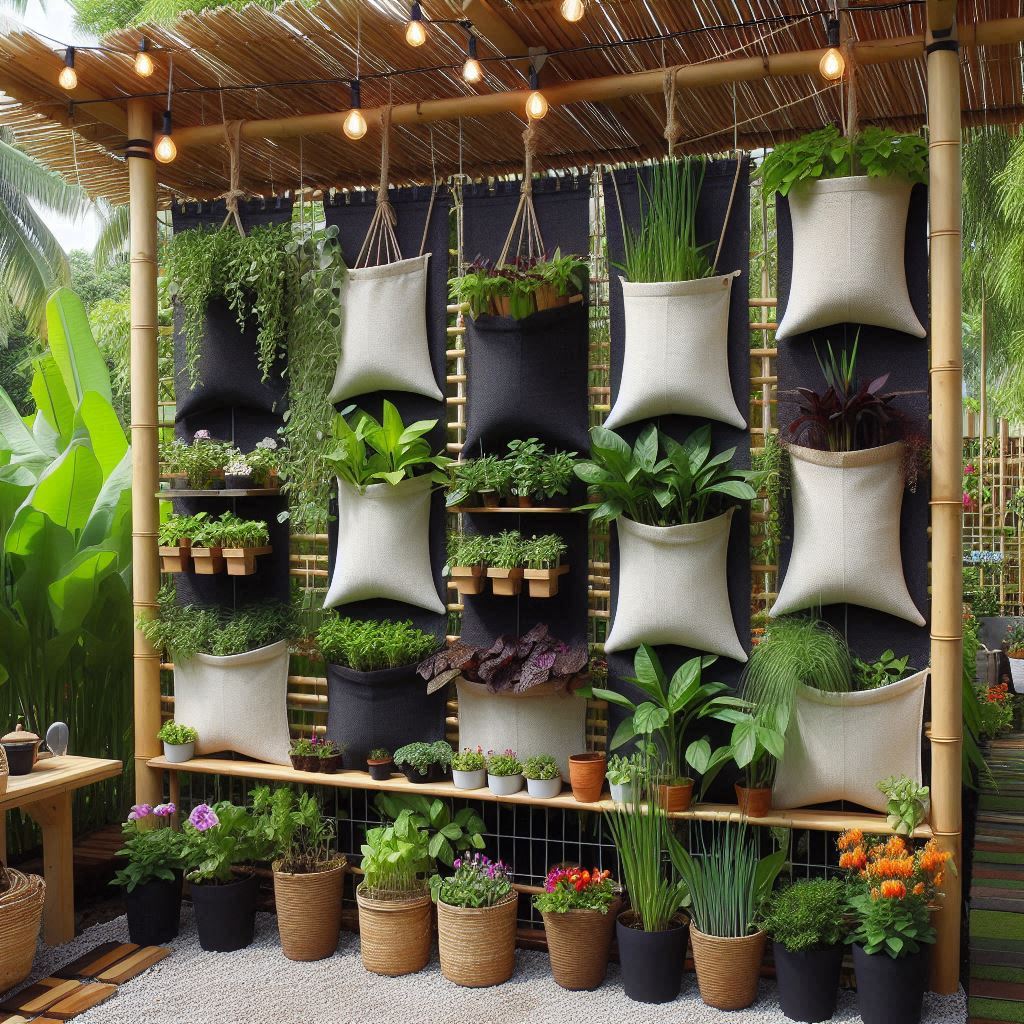
- Description: This innovative method utilizes fabric pockets filled with potting mix, attached directly to a frame within the raised bed.
- Materials List:
- Sturdy fabric (landscape fabric or felt)
- PVC pipes or wooden frame for support
- Heavy-duty staples or zip ties
- Scissors or utility knife
- Potting mix
- Pros & Cons: Lightweight, space-saving, and easy to customize. May require more frequent watering and can be susceptible to wind damage.
- Building/Assembly Instructions:
- Cut the fabric into desired pocket sizes.
- Create a frame using PVC pipes or wood, ensuring it fits securely within the raised bed.
- Secure the fabric pockets to the frame using staples or zip ties.
- Fill the pockets with potting mix and plant your chosen herbs, flowers, or leafy greens.
- Plant Recommendations: Herbs, lettuce, succulents, and other shallow-rooted plants flourish in fabric pockets.
(3) PVC Pipe Planters:
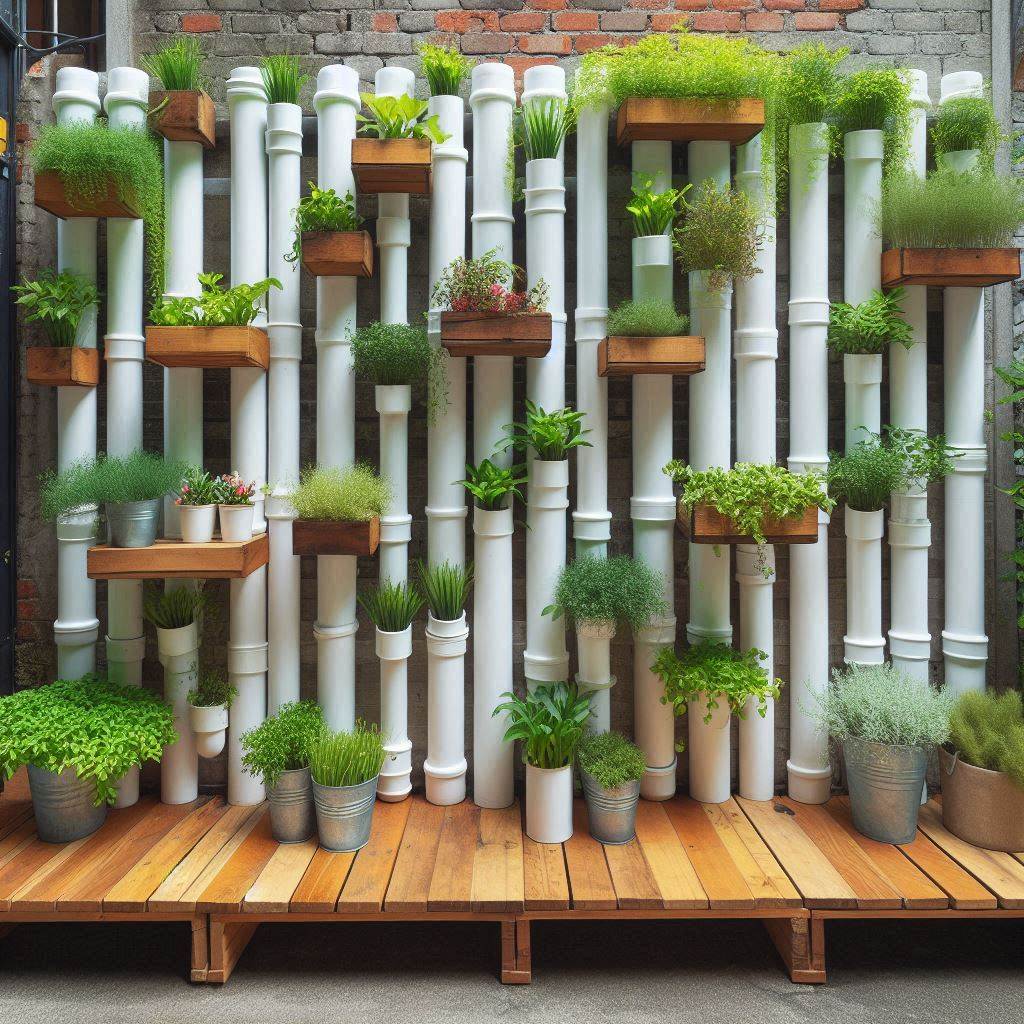
- Description: This budget-friendly method allows you to create vertical planters using readily available PVC pipes.
- Materials List:
- PVC pipes (various diameters depending on desired size)
- PVC pipe end caps
- Drill and saw
- Zip ties or wire mesh
- Potting mix
- Pros & Cons: Affordable, lightweight, and easy to customize. Requires careful planning for drainage and stability.
- Building/Assembly Instructions:
- Cut PVC pipes to desired lengths for the planter sections.
- Drill drainage holes throughout the pipes.
- Attach end caps to one end of each pipe section.
- Secure the pipes vertically using a frame made of zip ties or wire mesh within the raised bed.
- Fill the pipes with potting mix and plant your chosen vining vegetables or herbs.
- Plant Recommendations: Vining vegetables like peas, beans, and cherry tomatoes do well in PVC pipe planters. Herbs like rosemary and thyme can also be grown vertically.
(4) Cinder Block Garden:
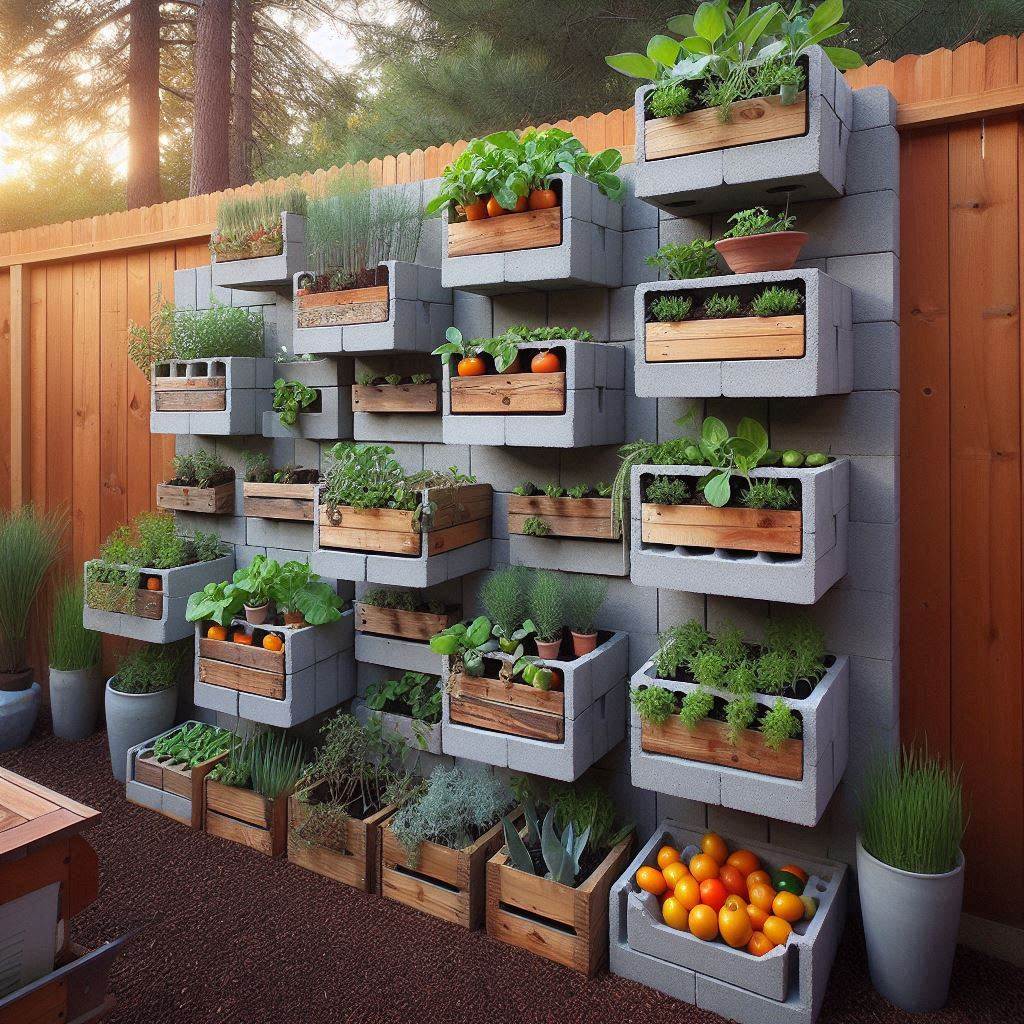
- Description: This rustic and functional method utilizes cinder blocks stacked on top of each other, with open spaces filled with soil for planting.
- Materials List:
- Cinder blocks
- Landscape fabric
- Drill and hammer (optional)
- Shovel
- Potting mix or garden soil
- Plants suitable for cinder block gardens (see recommendations below)
- Pros & Cons: Durable, low-maintenance, and creates a unique visual texture. Heavy and requires careful planning for plant placement.
- Building/Assembly Instructions:
- Choose a level location for your cinder block garden within the raised bed frame.
- Lay down landscape fabric to suppress weeds and improve drainage.
- Stack the cinder blocks in a desired pattern, leaving open spaces between them for planting. (Optional: Drill or hammer holes in the sides of the blocks for additional planting opportunities).
- Fill the open spaces with potting mix or garden soil.
- Plant Recommendations: Sedum varieties, succulents, herbs with trailing growth habits like thyme and oregano, and low-growing flowering plants like pansies or violas are all well-suited for cinder block gardens.
(5) Repurposed Ladder Garden:
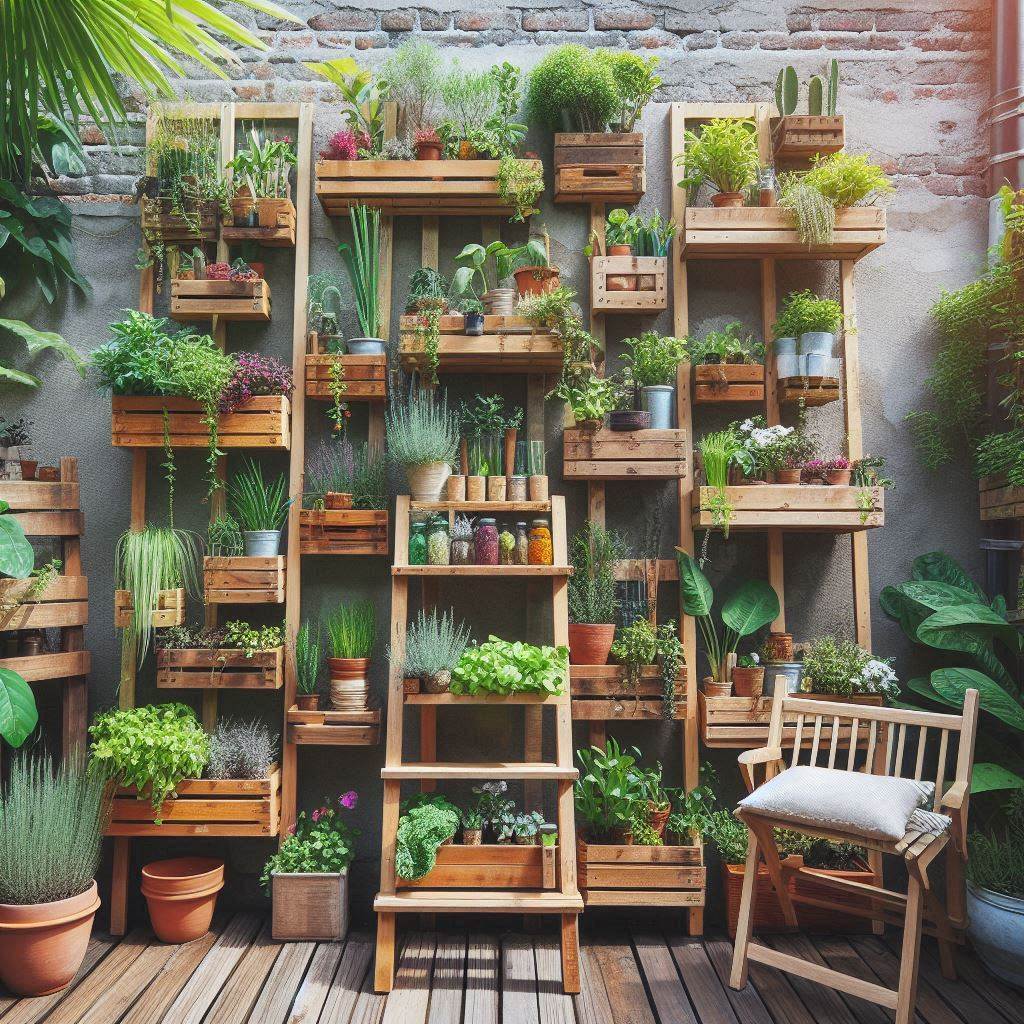
- Description: Breathe new life into an old ladder by transforming it into a charming vertical planter. Shelves or pockets can be attached to create a unique green display.
- Materials List:
- Old wooden ladder (sturdy and in good condition)
- Lumber (for shelves or planter boxes) or fabric (for pockets)
- Screws and drill
- Heavy-duty staples or zip ties (if using fabric)
- Potting mix
- Plants suitable for hanging planters (see recommendations below)
- Pros & Cons: Eco-friendly way to upcycle, adds a touch of vintage charm. May require additional support depending on the weight of the plants.
- Building/Assembly Instructions:
- Sand and paint the ladder if desired.
- Choose your method: Build shelves from lumber and secure them to the ladder rungs using screws. Alternatively, cut fabric into pockets and staple or zip-tie them to the rungs.
- Fill the shelves or pockets with potting mix and plant your chosen herbs, flowers, or trailing vegetables.
- Plant Recommendations: Trailing plants like cascading petunias, lobelia, or verbena are perfect for ladder gardens. Herbs with a cascading growth habit like thyme or oregano can also be incorporated.
(6) Pallet Garden:
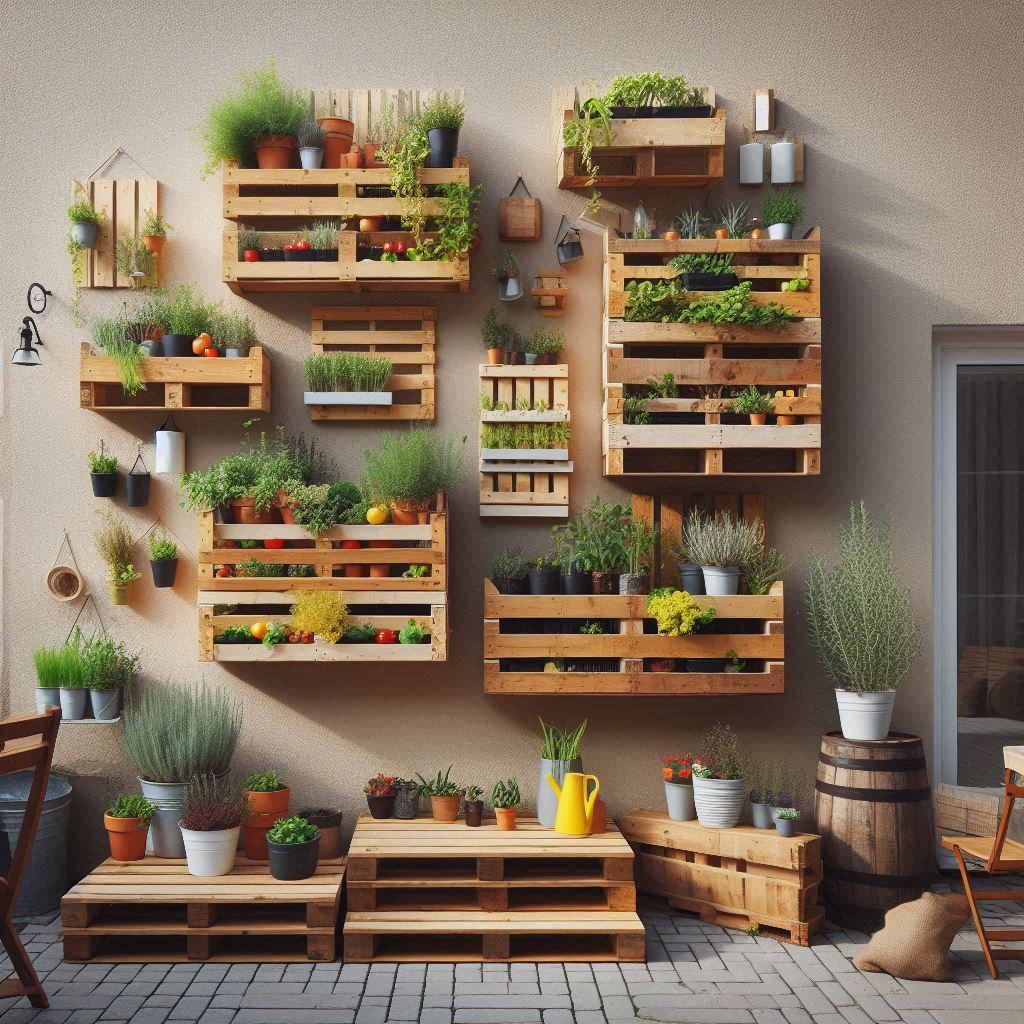
- Description: Disassemble a wooden pallet and use the reclaimed wood to create vertical planting sections within the raised bed.
- Materials List:
- Wooden pallet
- Saw or hammer (to disassemble the pallet)
- Drill and screws
- Weed barrier fabric
- Staple gun
- Potting mix
- Plants suitable for vertical planters (see recommendations below)
- Pros & Cons: Sustainable way to reuse materials, offers a rustic aesthetic. Requires some carpentry skills and may not be suitable for all plant types.
- Building/Assembly Instructions:
- Carefully disassemble the pallet, ensuring you have enough usable wooden slats for your design.
- Cut the slats to desired lengths for planter boxes or shelves.
- Assemble the wood pieces into planter boxes or shelves using screws.
- Line the planter boxes with weed barrier fabric and staple it securely.
- Fill the planters with potting mix and plant your chosen vegetables, herbs, or flowers.
- Secure the planters or shelves vertically within the raised bed frame using additional wood or brackets.
- Plant Recommendations: A variety of herbs, leafy greens like lettuce or spinach, and even small flowering plants like marigolds or pansies can thrive in pallet gardens.
(7) Hanging Baskets:
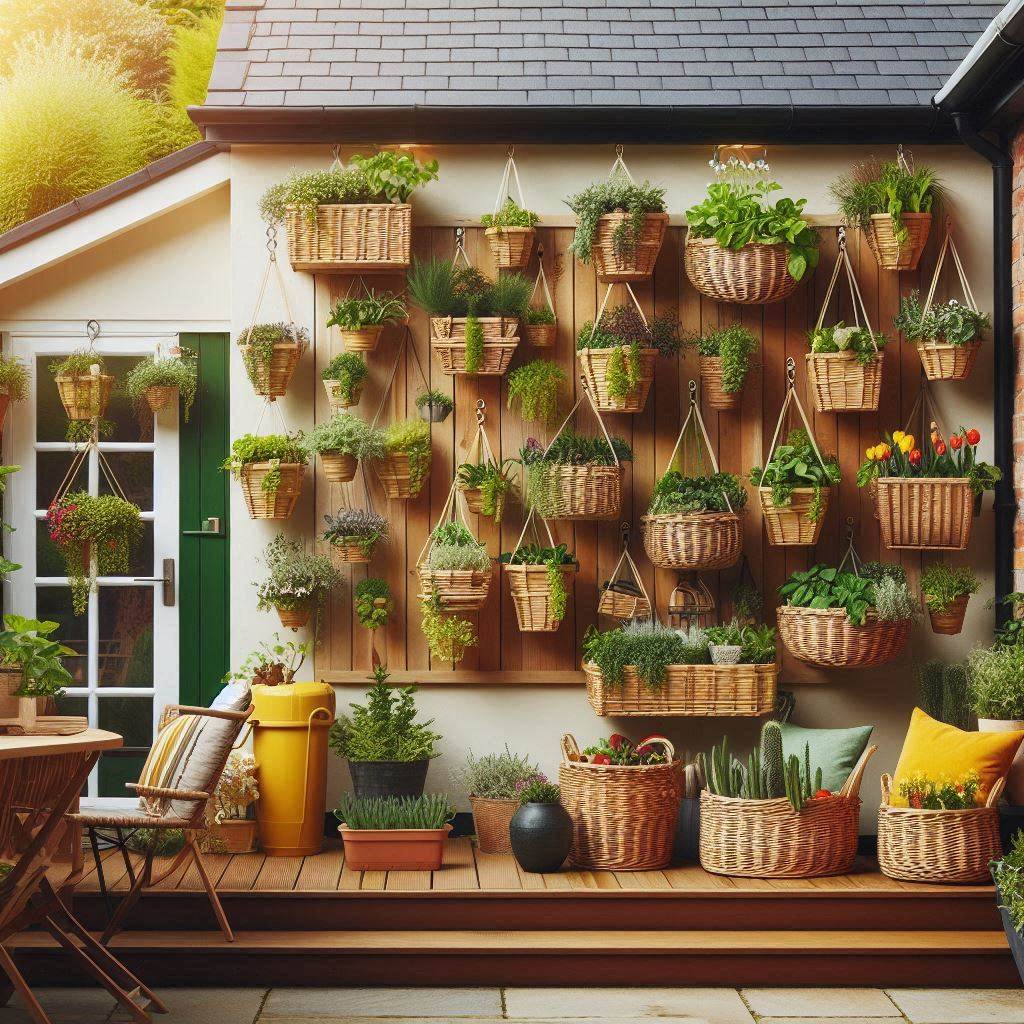
- Description: Suspending baskets from a frame built above the raised bed offers a classic and elegant way to introduce vertical gardening.
- Materials List:
- Sturdy frame materials (wood, PVC pipes, or metal)
- Hanging baskets (various sizes and styles)
- S-hooks or carabineers for hanging
- Potting mix
- Plants suitable for hanging baskets (see recommendations below)
- Pros & Cons: Provides flexibility in plant selection and placement, allows for easy maintenance. Requires a sturdy frame for support and may limit the number of plants you can grow.
- Building/Assembly Instructions:
- Construct a frame above the raised bed using your chosen materials. Ensure the frame is strong enough to support the weight of the hanging baskets.
- Select hanging baskets with good drainage holes.
- Fill the baskets with potting mix and plant your chosen flowers, herbs, or trailing vegetables.
- Hang the baskets from the frame using S-hooks or carabineers, ensuring they are securely in place.
- Plant Recommendations: Trailing plants like fuchsias, petunias, and million bells are ideal for hanging baskets. Cascading herbs like thyme or oregano can also be incorporated for a fragrant touch.
(8) Pocket Wall Planter:
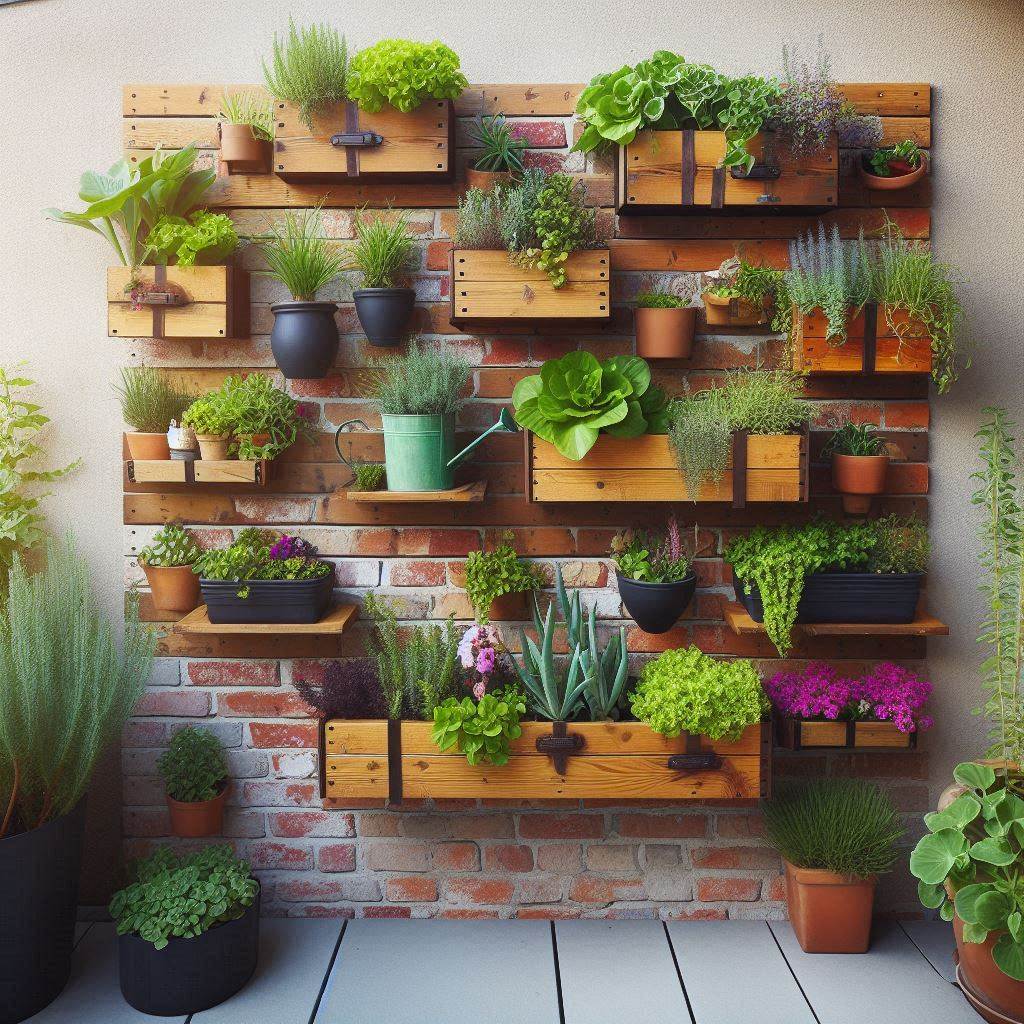
- Description: This space-saving method utilizes a dedicated pocket wall system attached to the inside of your raised bed frame.
- Materials List:
- Pre-made pocket wall planter system (fabric or plastic pockets with a sturdy backing)
- Screws or zip ties for secure attachment
- Potting mix
- Plants suitable for pocket planters (see recommendations below)
- Pros & Cons: Easy to install and maintain, allows for various plant combinations. May require purchasing a pre-made system and limits planting depth.
- Building/Assembly Instructions:
- Choose a pocket wall planter system that fits the dimensions of your raised bed frame.
- Secure the pocket wall system to the inside of the raised bed frame using screws or heavy-duty zip ties.
- Fill the pockets with potting mix and plant your chosen herbs, flowers, or trailing vegetables.
- Plant Recommendations: Shallow-rooted plants like lettuce, spinach, succulents, and herbs with trailing growth habits like thyme or oregano thrive in pocket wall planters.
(9) Repurposed Shoe Organizer:
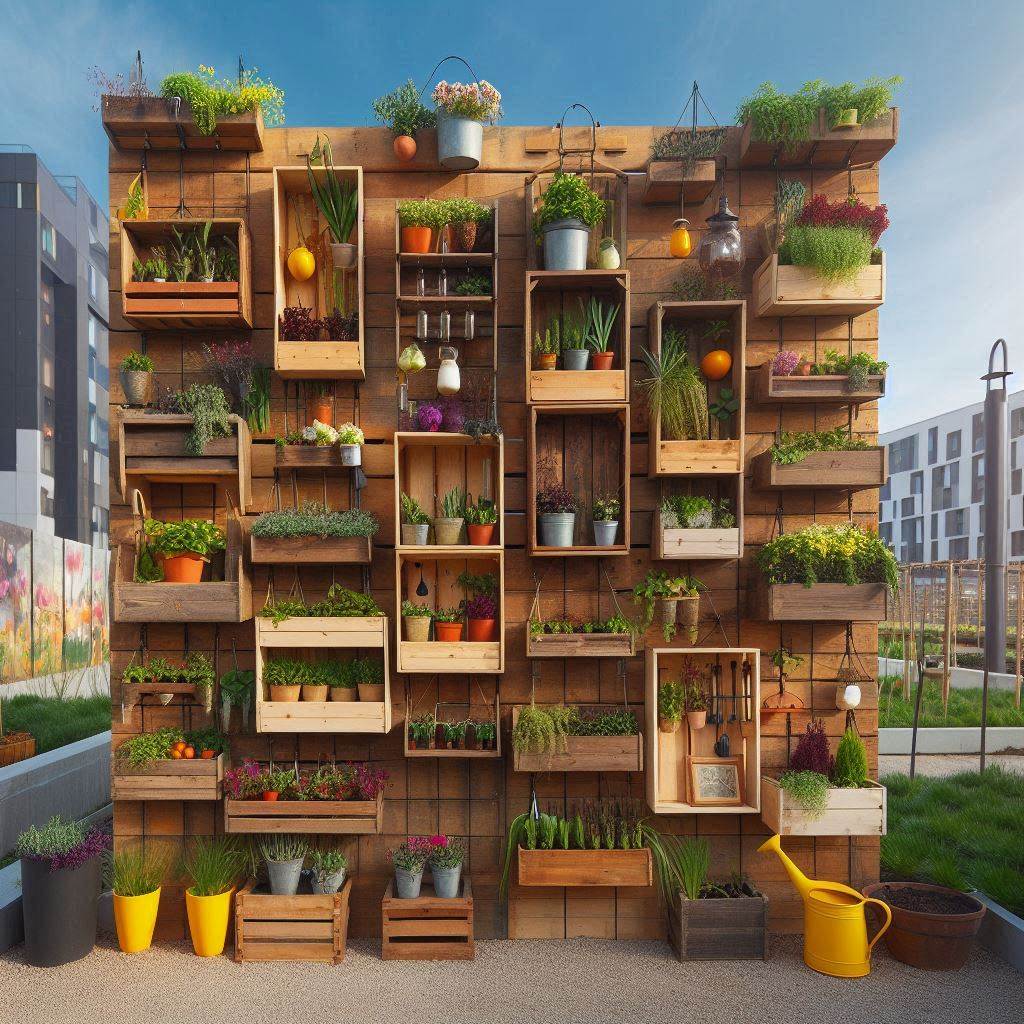
- Description: Breathe new life into an old over-the-door shoe organizer by transforming it into a vertical herb garden.
- Materials List:
- Over-the-door shoe organizer (fabric or plastic with sturdy pockets)
- Heavy-duty liner (optional, for improved moisture retention)
- Scissors or utility knife
- Potting mix
- Herbs (various varieties)
- Pros & Cons: Upcycles a household item, offers easy access to herbs for harvesting. May not be suitable for all plant types and can become heavy when watered.
- Building/Assembly Instructions:
- (Optional) Line the shoe organizer pockets with a heavy-duty liner if desired.
- Use scissors or a utility knife to enlarge the drainage holes in the bottom of each pocket if necessary.
- Fill the pockets with potting mix and plant your chosen herbs.
- Plant Recommendations: Aromatic herbs like basil, mint, parsley, and chives are well-suited for a repurposed shoe organizer herb garden.
(10) Hanging Tin Can Planter Wall:
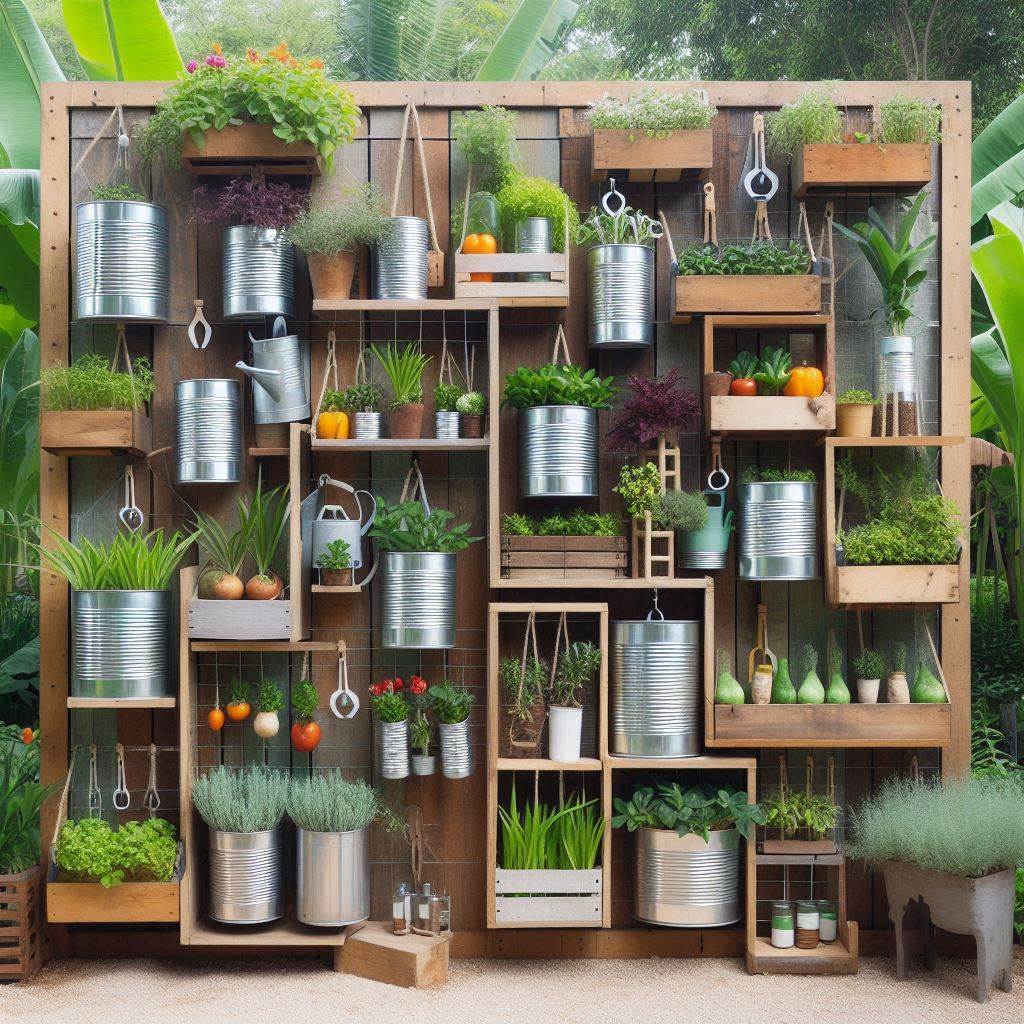
- Description: This creative method utilizes recycled tin cans transformed into charming hanging planters for a unique vertical display.
- Materials List:
- Empty tin cans (various sizes, washed and dried)
- Hammer and nail
- Sandpaper
- Paint (optional)
- S-hooks or carabineers
- Heavy-duty liner (optional)
- Potting mix
- Succulents or small flowering plants
- Pros & Cons: Eco-friendly way to recycle, creates a whimsical visual element. Requires additional effort for preparing the cans and may not be suitable for all plant types.
- Building/Assembly Instructions:
- Sand down any rough edges on the tin cans.
- (Optional) Paint the cans if desired.
- Using a hammer and nail, carefully punch drainage holes in the bottom of each can.
- (Optional) Line the cans with a heavy-duty liner for improved moisture retention.
- Fill the cans with potting mix and plant your chosen succulents or small flowering plants.
- Attach S-hooks or carabineers to the top rim of each can for hanging.
- Plant Recommendations: Succulents with shallow root systems and minimal watering needs are ideal for hanging tin can planters. Small flowering plants like pansies or violas can also be used.
(11) Living Wall System:
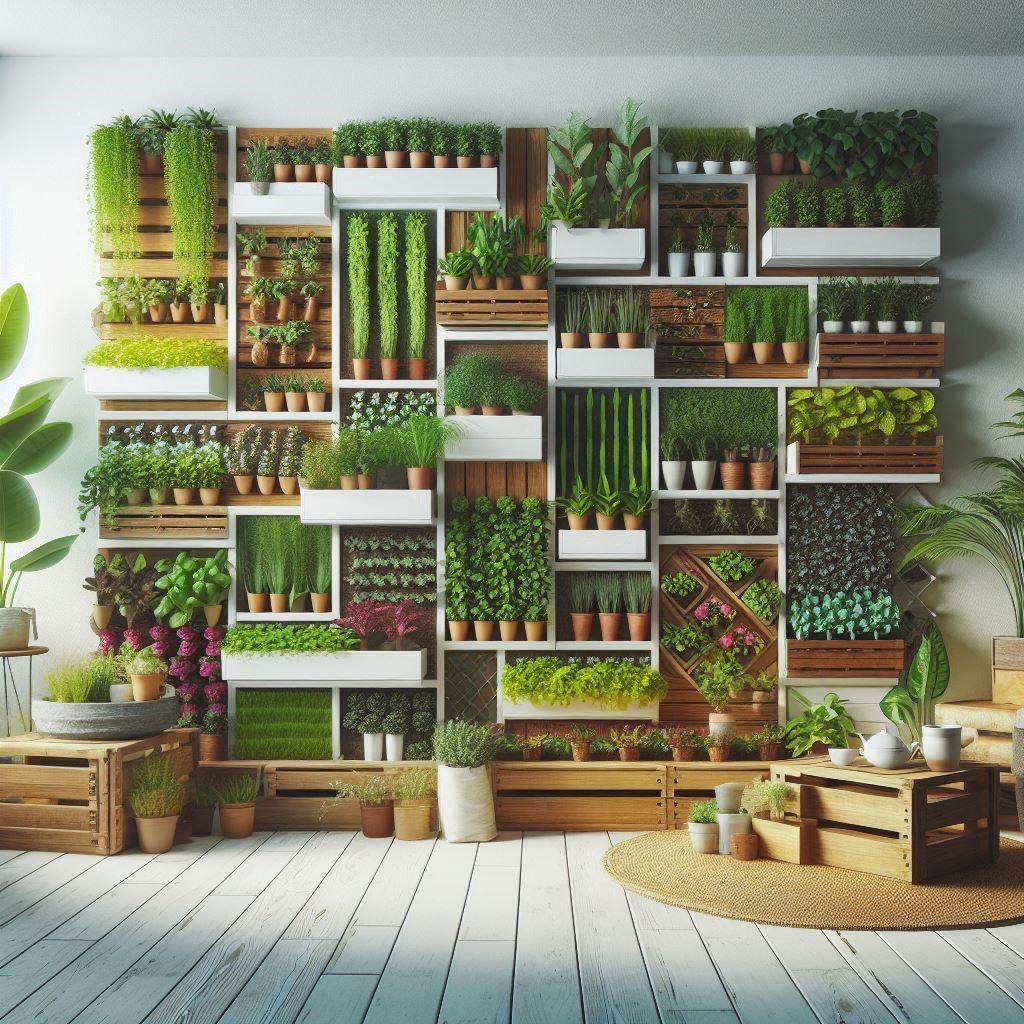
- Description: For a more substantial vertical garden, consider a pre-fabricated living wall system. These modular panels often come with built-in irrigation and offer a wide range of customization options.
- Materials List:
- Pre-fabricated living wall system (panels, mounting brackets, and irrigation system if desired)
- Potting mix specifically designed for living walls
- Plants suitable for living walls (see recommendations below)
- Pros & Cons: Provides a large-scale solution for vertical gardening, offers features like built-in irrigation for convenience. Requires a significant initial investment and may be more complex to install.
- Building/Assembly Instructions:
- Follow the manufacturer’s instructions for installing the living wall system panels and mounting brackets within your raised bed frame.
- Fill the designated planting areas with a well-draining potting mix specifically formulated for living walls.
- Plant your chosen foliage plants or flowering varieties according to the system’s instructions.
- Plant Recommendations: Many plants are suitable for living walls, but choose varieties with shallow root systems and low to moderate water needs. Ferns, bromeliads, certain mosses, and various flowering varieties like trailing verbena or lobelia can be effective choices.
Additional Tips for Vertical Gardening Success in Raised Beds:
Now that you’re equipped with a variety of DIY methods, here are some additional tips to ensure your vertical raised bed garden thrives:
- Choosing the Right Location: Consider sunlight availability, wind exposure, and proximity to a water source. Most vegetables and herbs prefer at least 6 hours of direct sunlight daily. If your balcony or patio receives limited sun, opt for shade-tolerant plants.
- Drainage is Key: Ensure proper drainage in your vertical planters to prevent waterlogging and root rot. Drainage holes are essential, and you may consider adding a layer of gravel at the bottom of planters to improve drainage further.
- Selecting the Right Potting Mix: Use a lightweight and well-draining potting mix specifically formulated for container gardening. Regular garden soil can be too heavy and retain too much moisture for vertical planters.
- Watering and Fertilizing: Vertical gardens tend to dry out faster due to increased airflow and exposure to sunlight. Monitor your plants regularly and water them deeply when the top inch of soil feels dry. Fertilize according to the specific needs of your chosen plants, but be mindful of not over-fertilizing in containers.
Embrace the Vertical Revolution
Vertical gardening in raised beds offers a unique and rewarding way to cultivate a lush and productive garden, even in limited spaces. With a touch of creativity and the methods outlined above, you can transform your balcony, patio, or any underutilized corner into a vibrant vertical oasis.
Remember, this is just the beginning! Feel free to customize these methods, experiment with different plant combinations, and explore online resources for further inspiration. Embrace the vertical revolution and watch your garden flourish!
We’d love to see your DIY vertical gardening creations! Share your photos and experiences in the comments below and inspire fellow gardening enthusiasts.

